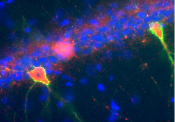Sabine Spijker
Full Professor
The focus of my team is on cognition and how it is affected by neuropsychiatric ailments, such as depression. We study maladaptation of synapses and circuitry brought about by unique molecular signatures in hippocampus and prefrontal cortex.


Our latest results shows involvement of the extracellular matrix (ECM), as can be viewed in our Science Translational Medicine paper, and how ECM changes develop over time in our recent papers in Scientific Reports and Neuroscience and Biobehavioural reviews.
As such, we focus on the hippocampal network where extracellular matrix-bearing Parvalbumin (PV) interneurons, pyramidal cells and astrocytes are major players. Current topics entail among others whether disturbances in PV interneurons and ECM levels over the course of development of the disease are necessary and sufficient to install the long-term ailments in spatial memory, how the interconnection between hippocampus and prefrontal cortex is affected, how sleep quality is related to the deficits observed.
Learning & memory & synaptic plasticity: We study how learning and memory processes depend on AMPA and NMDA receptor plasticity (including auxiliary subunits) using transgenic mice. See our latest contributions:
• eLife paper on the role of Shisa7 in the hippocampus
• Cell reports paper on the role of Shisa6 in the cerebellum with the group of Chris de Zeeuw
• Cell Reports paper on the role of Noelin1.
Current and previous collaborations:
We work in close collaboration with Priyanka Rao-Ruiz to study how where and to what extent aversive memories are formed, with molecular and cellular interventions of the dorsal hippocampus.
Furthermore, Eus van Someren (sleep quality), Huib Mansvelder (electrophysiology), Guus (August) Smit (glutamate receptors and associated proteins), Ka Wan Li (proteomics), Michel van den Oever (chemo- and optogenetics), Mark Verheijen (glial plasticity), Taco de Vries (addiction).
Postdocs:
• Annetrude de Mooij (role of PV cells in the lasting state of depression)
PhD students:
• Payam Safavi (mimicking the lasting effects of depression), related to our “Brainscapes”:https://brainscapes.nl project
• Femke Roig Kuhn (transition from stress to depression)
PhD students finishing up thesis
• Maija-Kreta Koskinen (Mouse model of persistent depression, parvalbumin interneurons), former CognitionNet trainee
Researchers:
• Remco V. Klaassen (Glutamate receptor modulation, Shisa proteins)
Technicial support:
• Rolinka van der Loo (behavioral test battery (e.g. cognition, anxiety), intracranial cannulation, intracranial virus injection, chemo- and optogenetics)
• Yvonne Gouwenberg (virus generation)
• Hugo Hoedemakers (intracranial surgeries (specifically related to mini-microscopes)
• Robbert Zalm (FGA ; construct generation)
• Yvar van Mourik (ANW; animal coordinator)